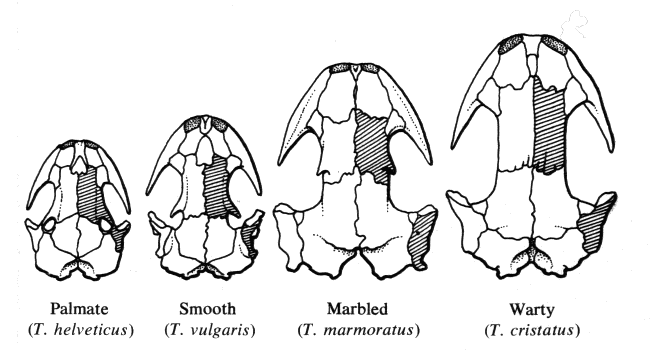
Until recently, all the common pond newts of Europe were contained in the genus Triturus, which was usually divided into two groups- the large-bodied newts, and the small-bodied newts.
Genetic studies in the early 2000s (e.g. García-París et al., 2004, Litvinchuk et al., 2005) suggested that it was appropriate to divide the genus into separate genera. This is because some of the species appeared to be more closely related to species from other genera (e.g. Euproctus, Neurergus) than to other species with the Triturus genus.
Several schemes were suggested, but it is now generally accepted that the large-bodied species (crested and marbled newts) should remain in the genus Triturus, with the small-bodied species (smooth, palmate, Italian, Montandon's and Bosca's newts) moved to Lissotriton (as suggested by García-París et al.).
Alpine newts now have their own genus of Ichthyosaura, which Schmidtler (2009) regarded as taking precendence over Mesotriton, which was the suggestion of García-París et al.
Banded newts, previously contained within T. vittatus, are now regarded as belonging to the genus Ommatotriton. This was suggested by Litvinchuk et al., who also proposed that this genus should contain two species, Ommatotriton vittatus for the Southern populations, and Ommatotriton ophryticus for the Northern populations.
In addition to the changes in generic names, older publications may use different specific names for some of the species; T. palmatus was sometimes used for L. helveticus, T. taeniatus was used for L. vulgaris, and T. blasii was used to describe the natural hybrid between T. cristatus and T. marmoratus. In addition, other species were included in the genus, which are now considered to belong to other genera; the genera Notophthalmus and Cynops are two such examples. Very early writings used Triton instead of Triturus.
Despite the presence of so many newt species in Europe, there is limited overlap between them, and the largest number present in one area is five (Arntzen and De Wijer, 1989). This maximum concentration occurs in northwest France, at the overlap of the range of T. marmoratus and T. cristatus, where I. alpestris, L. vulgaris, and L. helveticus also occur. Even where this many species occur, differing habitat preferences may mean that there is little actual contact between newts of different species.
Large-bodied newts (Triturus)
Small-bodied newts (Lissotriton)
Alpine newts (Ichthyosaura)
Banded newts (Ommatotriton)
Note: the distribution maps on the species pages are adapted from those published in Macgregor, Sessions and Arntzen (1990).
IDENTIFICATION
Arnold & Burton (1978) give some detail on identifying European newt species by skull features.
Note: taxonomy in this excerpt reflects what was used at the time of publication; for instance T. cristatus included all of what is now the crested newt subspecies, and Lissotriton and Ichthyosaura were not in use.
"Two of the bones on each side of the skull, the frontal and the squamosal, often have projections that may meet to
form a structure called the fronto-squamosal arch. Sometimes the arch is completely bony, but often it is interrupted
in the middle or is entirely absent. Among European species, the structure usually varies as follows (Fig., below):

REFERENCES
Arnold, E. N., & Burton, J. A., 1978. A Field Guide To The Reptiles And Amphibians Of Britain And Europe. Collins, London
Arntzen, J. W., & De Wijer, P., 1989. On the distribution of the Palaearctic Newts (genus Triturus) including the description of a five species pond in Western France. British Herpetological Society Bulletin 30: 6-11
García-París, M., Montori, A., & Herrero, P., 2004. Amphibia: Lissamphibia. Fauna Ibérica, Vol. 24. Museo Nacional de Ciencias Naturales, Madrid.
Litvinchuk, S. N., Zuiderwijk, A., Borkin, L. J., & Rosanov, J. M., 2005. Taxonomic status of Triturus vittatus (Amphibia: Salamandridae) in western Turkey: trunk vertebrae count, genome size and allozyme data. Amphibia-Reptilia 26(3):305-323.
Macgregor, H. C., Sessions, S. K., & Arntzen, J. W., 1990. An integrative analysis of phylogenetic relationships among newts of the genus Triturus (family Salamandridae), using comparative biochemistry, cytogenetics and reproductive interactions. Journal of Evolutionary Biology 3: 329-373.
Schmidtler, J. F., 2009. Ichthyosaura, der neue Gattungsname für den Bergmolch – ein Lehrbeispiel in Sachen Nomenklatur Zeitschrift für Feldherpetologie 16: 245-250. [PDF]
